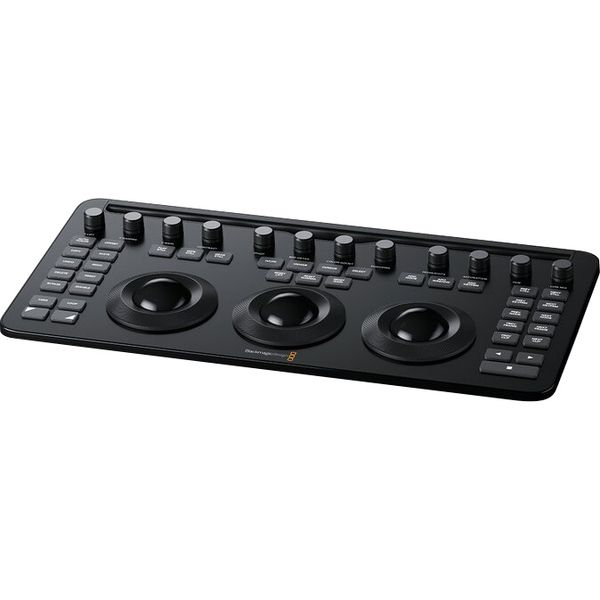I worked behind an old Micro Panel for several years. I worked for a month at the new one and here are my thoughts:
1. Size and Weight. When I opened the box, my first thought was, “Wow, this is tiny.” And it’s true — the panel is noticeably smaller and lighter than the old Micro Panel, which I had been using for several years.
This is mostly a plus: I always felt the old Micro Panel could either fit more buttons or be less bulky. The new panel achieves both — it’s smaller and has more buttons. However, this came at the cost of the trackballs and rings, which I’ll discuss later.
2. Material. When the panel was announced, I was immediately put off by the fact that it’s made of plastic. The old Micro Panel’s metal construction offered excellent tactile feedback. Thankfully, the plastic used for the new panel is high-quality. While it doesn’t match the premium feel of metal, it doesn’t look or feel cheap or toy-like either.
One drawback of the plastic is that it quickly collects fingerprints. With the old panel, I only occasionally wiped off dust, but this one requires more frequent cleaning.
The build quality is good: nothing sticks, and everything rotates and clicks smoothly. I’ve heard some users experienced issues with sticky trackballs, but I haven’t had that problem.
3. Trackballs and Rings. The trackballs and rings are now smaller, and the rings are plastic. My hands are not small, so I thought this would significantly hinder usability, but I adapted faster than I expected. At first, I would sometimes accidentally touch the trackball while using the ring, but this quickly stopped being an issue.
That said, the trackballs and rings on the old Micro Panel are undeniably better by a significant margin.
4. Buttons and Knobs. This is a bit more nuanced:
The buttons on the old panel were soft and pleasant to use, though they occasionally felt a bit loose. On the new panel, the buttons are rigid and plastic, giving off a “cheap keyboard” vibe. It’s not a dealbreaker, but it feels worse in comparison.
The knobs are smaller, and at first, this felt awkward and annoying. While I’ve gotten used to them, the smaller panel size combined with more buttons and shorter knobs means I sometimes accidentally bump a knob when pressing a button. This can be frustrating.
5. Log and Loop Buttons. On the old panel, the Log button lit up when Log Wheels mode was active. Now it doesn’t, so I have to check the screen to see whether I’m in Log or Primaries mode. The Loop button has a similar issue — while it’s still there, it no longer lights up when active. This is inconvenient.
6. Buttons and Features. After pointing out some negatives, let’s talk about the positives. In my opinion, this is how the old Micro Panel should have been from the start. I don’t know why it took them so long to add these features.
Mask control, adding nodes (finally!), flags, markers, keyframes, split-screen, switching stills, and more — all of this is fantastic. These additions significantly expand the panel’s functionality in day-to-day work.
7. Useless Buttons and Features. Colorists had been waiting for years for a button to switch to HDR Wheels. Unfortunately, it’s still not here. Owners of both Micro Panels still have to find workarounds or use a mouse to access this feature.
Meanwhile, the new panel has an AUTO COLOR button and a USER button, which, at the time of release… doesn’t even work. Plus, you can now use the trackballs to control frame Transform — a completely pointless feature. It feels like this could have been implemented much better.
***
Overall, the panel is interesting. Yes, it required some adjustment, as it has a completely new form factor. The plastic bothered me at first, but I got used to it after a couple of weeks.
I decided to stick with this panel because it offers more interaction with the software — and for me, that outweighs all the downsides. After a month, I find it doesn’t get in the way of my work, which is already a win. The added features are genuinely helpful. I wouldn’t say it’s made me faster, but not having to reach for the mouse as often is definitely more comfortable.
If tactile feel is important to you, I recommend the old Micro Panel for a first-time buyer. Plus, it comes with a DaVinci license right out of the box. While it has fewer features, I never found that limiting in years of use. Paired with a Stream Deck, it’s an excellent solution.
I’d recommend the new Micro Color Panel to those who need as many features as possible in a compact, affordable package. In this niche, it has no real competition. Let’s see if they release a new Mini Panel version with a smaller form factor.

















